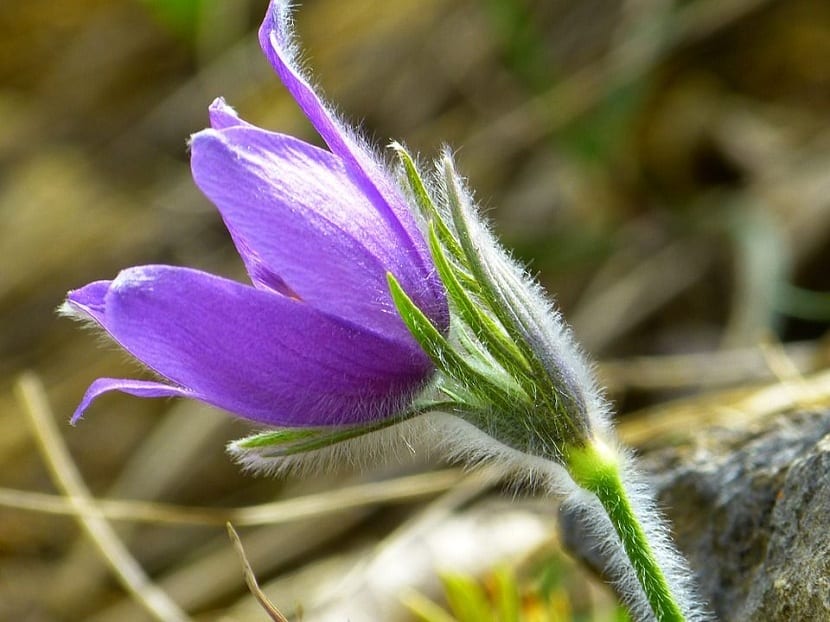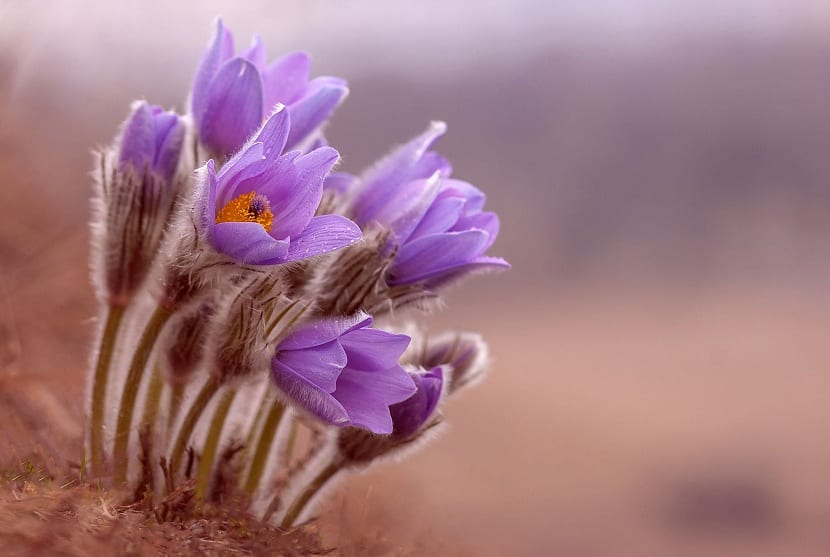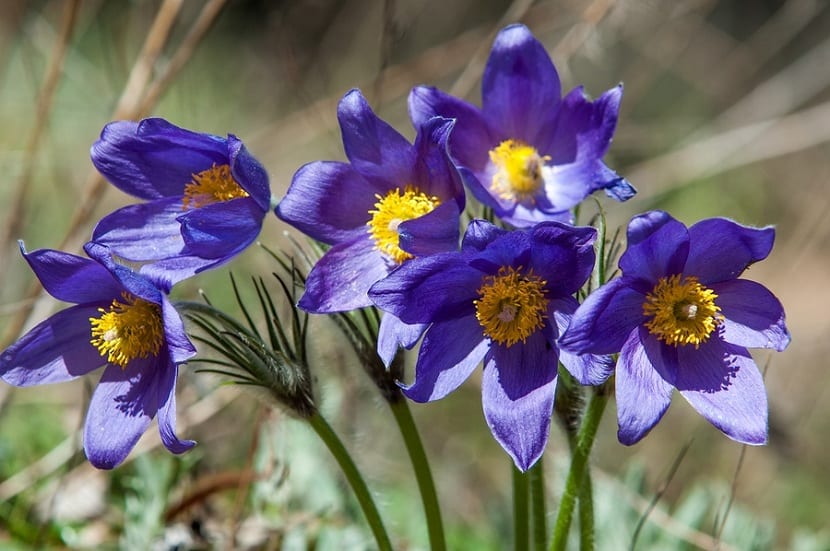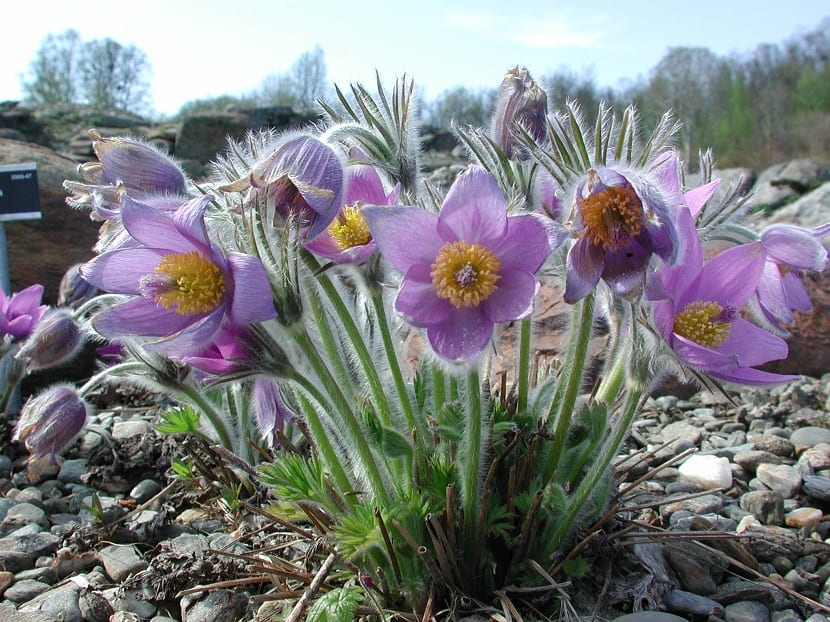
In homeopathy some types of plants are used to combat some diseases. The amount supplied is usually small, since if administered in higher doses, they would trigger the same effects that you want to combat.
In this case we are going to talk about the Pulsatilla. His scientific name is pulsatilla vulgaris and it is a genus of plants that consists of about thirty species and that are used in homeopathy for the treatment of various diseases. Do you want to know more about the pulsatilla?
Characteristics of the pulsatilla

The pulsatilla is distributed in mountainous areas or meadows with a large grass mass. They are mostly found in the mountain areas of North America, Asia, and Europe. Its leaves are hairy and its bell-shaped flowers have a deep bluish, violet or purple color, and are one of the first flowers to bloom in spring.
They are perennial plants but their leaves are deciduous. They are mainly characterized by having the underground rhizomes from which the leaves are born in the form of a basal rosette. When blooming in spring, it is also known by the name of poinsettias.
Regarding the shape of the leaves and stems, we find something special: this plant has a whitish gray hairiness that gives them a velvety texture when touched. This hairiness is due to the adaptation to mountainous climates that helps them to better resist low temperatures, broadens the surface through which the surrounding oxygen enters and protects from the sun's rays.
Properties and uses of the pulsatilla

The pulsatilla it should not be prepared at home since it is extremely toxic and improper use of it could cause serious injuries, depending on the time the plant is in contact with the skin.
The pulsatilla is used especially by homeopathy for medicinal purposes. Among the diseases that are treated thanks to this plant, we find: colds, diseases related to the liver, depression, incontinence, spasms, etc.
The part of the pulsatilla that is used for healing methods it is the grass and not the flower.
Pulsatilla is frequently used in homeopathy to treat various problems such as:
Respiratory problems
These are colds with excess mucus and secretions. They are also used in other respiratory conditions such as bronchitis, sinusitis, etc. The signal that is used to know if the pulsatilla should be used is that these conditions go accompanied by copious mucus and coughing that give rise to abundant yellowish sputum.
Behavioral problems in children
For children with problems such as excessive tantrums, shyness, lack of security, whims, irritability, etc. The pulsatile of a homeopathic way.
Menstruation problems
When a woman has irregular periods and does not adjust to the normal period, the pulsatilla can be used to be able to regulate them again.
Different types of pain
When there are people who frequently suffer severe pain such as headaches, toothaches, mumps… Is used to reduce this pain.
Digestive problems
For people who have problems with digestion or a poor liver, you can use remedies made with pulsatilla to help against indigestion. In addition, it helps the stomach and liver work better and prevents the appearance of symptoms of poor digestion such as nausea, vomiting and flatulence.
Weak personality problems
For those people who have a weak personality, such as those who are insecure, shy, who think that they are going to abandon them or who suffer from anxiety, the pulsatilla can be used. It can also help those who suffer from sadness, melancholy, a tendency to cry, loneliness or suicidal thoughts.
How is a person who requires pulsatilla detected?

To identify a person who needs pulsatilla it is necessary to look at certain patterns of behavior and behavior:
- People who are usually very sweet, gentle and softBut deep down they really need love, and comfort they need pulsatilla. To recognize them we can see how they constantly need hugs, praise, recognition for others, in general affection.
- People who tend to cry easily and without apparent cause are usually those who perceive and connect with great depth the pain and problems of others.
- These people tend to blush very easily. In addition, they are often indecisive and lack self-confidence. Many constantly feel sensations like that of being abandoned, rejected, helpless, etc.
- People with suicidal tendencies, strong anxieties and who have deep sadness.
- Some people who need pulsatilla may have a poor memory and do not like physical activity.
- They often have dizziness when they get up and need to lie down again.
Pulsatilla toxicity

As mentioned before, it is not advisable to use pulsatilla in home remedies, since it is highly toxic. When the fresh plant is eaten, it can produce seizures and cause significant irritating injury to the stomach.
Another effect that pulsatilla can have is to initially stimulate the nervous system, but later it causes its depression and can lead to death.
The main symptoms that are had by the ingestion of the pulsatilla are the following:
- Tingling in the mouth and tongue
- Facial stiffness
- Increased saliva
- Vomiting
- Inability to swallow
- Blurred vision
- Arrhythmia
- Seizures
- Death
To treat a person who has consumed pulsatilla, a a stomach lavage and assisted breathing.
Farming

The pulsatilla is a plant whose state of conservation is high. Therefore, it cannot be collected in the wild. It can be grown manually in cool places.
If we want to use the pulsatilla for other uses that are not medicinal, we can use them to decorate slopes or rockery in the open air. In order for them to survive in these places, they must be planted in a cool place in semi-shade. These plants resist the cold quite well due to their hairs and thanks to the adaptation they have had throughout their evolution to living in high mountain areas. Although they resist the cold well, it is always preferable to protect it. These plants prefer colder winters and cooler summers.
To reproduce them, the most normal thing is mmultiply them from rhizomes when autumn begins or by seeds that will sprout when spring arrives.
The best soil to keep the pulsatilla in good condition is a soil composed of mulch, garden soil and sand. To water it, it should be done daily but without puddling around it.
You already know a little more about pulsatilla and its properties and thanks to it many people are cured of their diseases.
I took my wife for many years to operate for sinusitis because she had all her nostrils blocked with many headaches and dizziness and as I am a carpenter I was taking a job and I told her about my wife and she told me to take her away and the first week he felt no more pain and after three months we took another x-ray and there was no obstruction and the ENT could not believe it this is my comment on the pulsatilla and thanks to doctor mario draiman of the omeopathic medical association
Hello, I would like to know how to take the pulsatilla DC to cure urinary incontinence
Hello Monica.
We cannot answer this question for you. We recommend that you contact a healthcare professional.
Greetings.